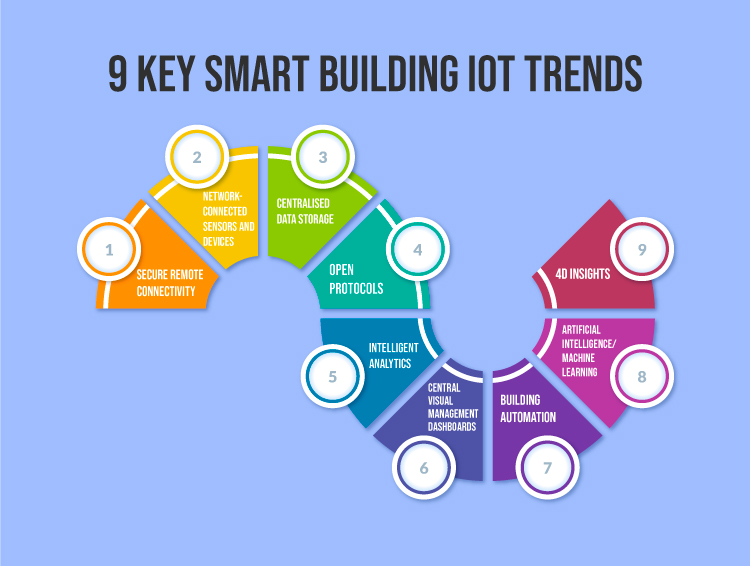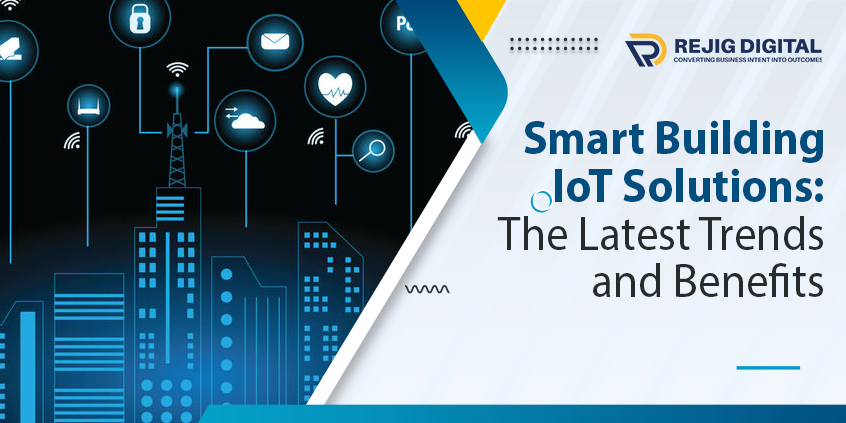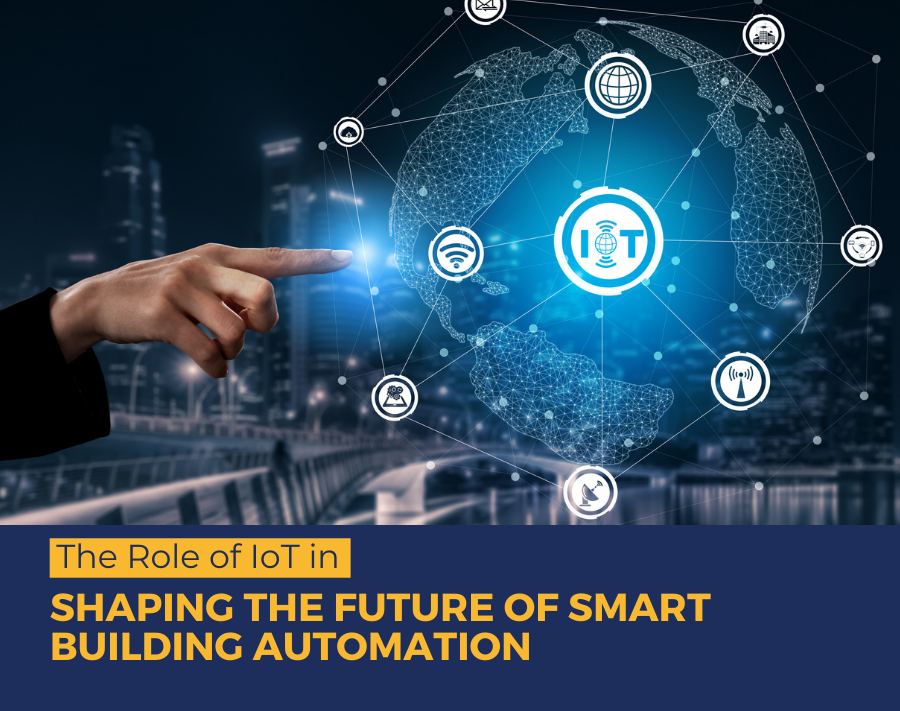The concept of a Smart Building is around for a while, however, there is still a long way to go in its comprehensive implementation. As IoT becomes more advanced, smart buildings are also being utilised for optimum energy usage and maintenance costs. Smart Building IoT solutions make the environment safe and comfortable that avoid equipment breakdowns and disruptions to occupants.
Thus, it is not surprising that demand for smart buildings is increasing among building owners, managers, and tenants owing to its multiple benefits. Some of the trends, scenarios, and payoffs are worth investing in IoT-powered smart buildings.
According to Fortune Business Insights, the global smart building market is expected to grow from $80.62 billion in 2022 to $328.62 billion by 2029, at a CAGR of 22.2% in the forecast period, 2022-2029.
What is Smart Building?
A smart building involves a connected framework that enables information sharing across systems in order to optimise performance. The collected information is utilised for automating various processes within the building spans from heating to security.
The application of smart technology makes the building efficient and also for the users within it. Furthermore, it also results in significant cost-savings and energy efficiency.
However, a smart building is more than just an automated entity. An automated building allows occupants/tenants the ability to control lighting and heating from their smartphone, and answer the door remotely, giving visibility to who’s at their front door even if they’re out of the building. But this doesn’t make a building smart as it needs decision-making by a human to activate the actions.
What makes a building go from an automated to a smart one is when these judgements are performed automatically by technology without human intervention. For instance, occupancy sensors refer that the building is always empty at certain hours of the day. Therefore the building automatically switches off lighting, heating, air conditioning and so on at certain hours.
A smart building programmes itself based on the environment and predicts future behaviours.
9 Key Smart Building IoT Trends

A Smart Building using IoT refers to a network of equipment, sensors, and devices that communicate with each other. When it comes to commercial buildings, this usually involves information from key building equipment like HVAC, security, and lighting systems. As technology evolves and smart systems become a crucial aspect of both new construction and retrofits, new opportunities and best practices are emerging.
Here are the key smart building IoT trends.
-
Secure Remote Connectivity
Remote connectivity is one of the sought-after trends of IoT smart building trends. It allows service contractors and facility teams to monitor and troubleshoot systems without being near the equipment. IoT has boosted the coordination with service providers for secure network connectivity and user authentication strategies. It ensures safe and efficiently managed connectivity to integrated building systems.
-
Network-Connected Sensors and Devices
Suitable network-connected sensors and devices can collect actionable data from a wide range of building equipment. The whole framework can measure and correlate different variables such as detection, occupancy numbers, temperature, humidity, lighting, and energy, to name a few.
-
Centralised Data Storage
Smart Building IoT technology solutions allow automated data collection from operational systems. As a result, the data will transfer constantly from equipment and devices to a central database and unified reporting system. It will provide quick visibility into any integrated system and its problems. The user can decide on certain courses of action for operational modifications to improve comfort or increase efficiencies in the building.
-
Open Protocols
Open protocol support enables IoT-based devices and cloud-hosted systems connected to BMS for collective usage in a common system. Users can create a customized management interface from the integration of IoT devices with other systems as per their requirements. Hence, there will be no limitation of working with certain tools available from vendors using proprietary protocols.
-
Intelligent Analytics
Intelligent building analytics is tremendously effective for managing operations and improving efficiency. As IoT collects large volumes of data, its robust analytics is highly useful in making this data meaningful for users which can lead to informed decisions.
-
Central Visual Management Dashboards
Visual and custom-configured dashboards allow the creation of operating systems together in one single, web-accessible interface. Flexible and dynamic dashboards are synonyms for a powerful tool which analyses data that is collected from a wide range of IoT devices.
-
Building Automation
Integration of IoT in hardware and software drives the automation of various building functions. It is one of the important benefits of IoT technologies. Effective automation systems reduce human intervention which minimises errors and enhances operational performance. In a way, IoT is a suitable choice for managing energy-related objectives of smart buildings through efficient automation.
-
Artificial Intelligence/Machine Learning
With AI/ML, IoT software can monitor and understand patterns within humongous datasets. As a result, various processes of a smart building can be accelerated that may otherwise take much longer when reviewing and decoding manually.
AI/ML facilitates the analytics system to learn the various operation of a smart building over time. For instance, AI/ML pattern recognition includes detecting excessive energy usage, identifying energy savings opportunities, alerting regarding equipment and system failures before they occur, and recommending solutions to operational problems with minimal human interference.
Relying on the powerful approach of AI/ML leads to automatically initiating various actions such as changes to building systems or device behaviour without human involvement.
-
4D Insights
IoT-based multi-layered analytics use data from equipment, sensors, and components that are beneficial in fault detection and diagnostics. Real-time and historical data gathered according to smart rules can provide context to alarms and suggest solutions.
How are IoT Smart Building Trends Beneficial?

The benefits of smart buildings are achieved by the data-generating nature of IoT. Here’s a look at some of the benefits of smart buildings and why they’re so important.
-
Add Value to Buildings
It’s easy to approach tenants and occupants for sanitised, healthy, safe, and comfortable spaces. Adopting smart building IoT solutions improves the appeal of the existing buildings which attracts and retains top-tier tenants. Smart buildings also come with faster lease-up rates, and higher sale prices, and are mostly eligible for incentives such as zoning allowance and tax rebates. Overall, Smart buildings are a valuable entity.
-
Decrease Operational Costs
Smart building IoT solutions significantly reduce operational costs. It helps in identifying and correcting inefficiencies, streamlines maintenance, strategically allocates facility resources and optimises ROI on capital projects.
-
Improve Internal Environment
IoT sensors allow occupants to know the CO2 level in room air as well as various attributes related to indoor air quality, such as humidity, temperature, etc. Once the CO2 intensities reach the threshold, the sensor will immediately send out the alert to Cloud. The notification gives users an indication of increasing the ventilation frequency. Lower carbon dioxide can improve cognition which improves work productivity.
-
Centralised Services
IoT-based centralised services remotely provide deep insights on how to optimise building operations, save costs, improve comfort, and address air quality. It is the best step for building managers to overcome skill shortages where they don’t have to hire from a limited pool of talent. The data provided by connected buildings helps enables informed decisions which ensure corrective actions.
Conclusion
The potential of IoT smart building solutions is such that can be applied across all property classes – from office and retail to residential and campuses. Being able to stay on top of major market trends, property owners can strategise accordingly and bring out the best for occupants and inhabitants.
Rejig Digital specialised in Industrial IoT technology and expanding its horizon for smart buildings. Our IIoT solution- Arete- enables smart buildings for monitoring and optimising all the integrated systems.



